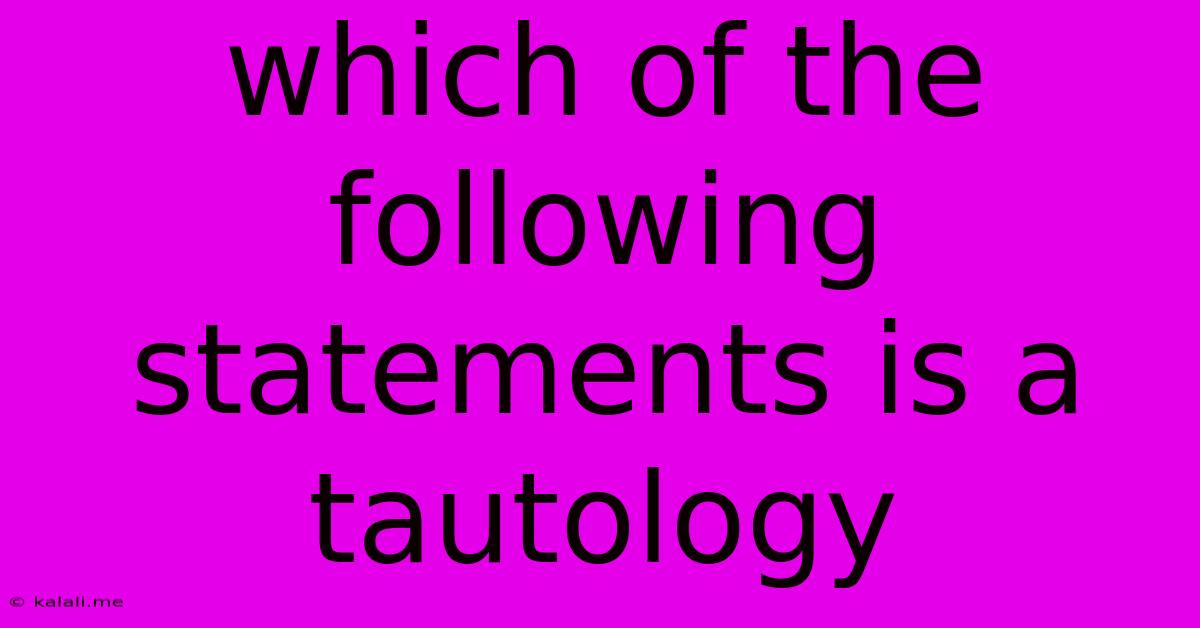Which Of The Following Statements Is A Tautology
Kalali
Jun 14, 2025 · 3 min read

Table of Contents
Which of the following statements is a tautology? A Deep Dive into Logical Truths
This article explores the concept of tautologies in logic, explaining what they are and how to identify them. We'll examine several example statements and determine which ones qualify as tautologies, illustrating the principles involved. Understanding tautologies is crucial for various fields, including mathematics, computer science, and philosophy, as they represent statements that are always true regardless of the truth values of their components.
What is a Tautology?
A tautology is a statement that is always true, no matter the truth values of its individual components. In simpler terms, it's a statement that's logically true by its structure. This is different from a statement that is factually true – a tautology's truth is guaranteed by its logical form, not by its connection to the real world. Think of it as a self-evident truth within the system of logic. We often use truth tables to verify if a statement is a tautology.
Identifying Tautologies: A Step-by-Step Approach
To determine if a statement is a tautology, we typically use truth tables. Let's break down the process:
-
Identify the simple statements: Break down the complex statement into its individual components (simple propositions). For example, in the statement "P or not P," the simple statements are "P" and "not P."
-
Construct a truth table: Create a truth table with columns for each simple statement and a final column for the complex statement. The number of rows depends on the number of simple statements (2<sup>n</sup>, where 'n' is the number of simple statements).
-
Assign truth values: Assign all possible combinations of true (T) and false (F) values to the simple statements.
-
Evaluate the complex statement: Using the truth values of the simple statements, evaluate the truth value of the complex statement for each row. This involves applying the logical connectives (AND, OR, NOT, etc.).
-
Check for all true values: If the final column of the truth table contains only "T" values, then the statement is a tautology.
Example Statements and Their Analysis:
Let's analyze a few example statements to illustrate the process:
Statement 1: P ∨ ¬P (P or not P)
This is a classic example of a tautology. The truth table shows that it's always true:
| P | ¬P | P ∨ ¬P |
|---|---|---|
| True | False | True |
| False | True | True |
Statement 2: P → (P ∧ Q) (If P, then P and Q)
This statement is not a tautology. If P is true and Q is false, the statement is false.
| P | Q | P ∧ Q | P → (P ∧ Q) |
|---|---|---|---|
| True | True | True | True |
| True | False | False | False |
| False | True | False | True |
| False | False | False | True |
Statement 3: (P → Q) ↔ (¬P ∨ Q) ( (P implies Q) is equivalent to (not P or Q))
This is a tautology. It represents a fundamental equivalence in logic, showing the relationship between implication and disjunction. The truth table would demonstrate that the final column only contains "True" values.
Statement 4: (P ∧ Q) → P (If P and Q, then P)
This is also a tautology. It's intuitively true; if both P and Q are true, then P must be true. A truth table will confirm this.
Conclusion:
Determining whether a statement is a tautology involves a systematic approach using truth tables. Understanding this process is key to working with logical statements and reasoning effectively. Tautologies represent fundamental truths within the framework of logic, providing a solid basis for more complex logical arguments and proofs. By mastering the techniques outlined here, you can confidently analyze logical statements and identify those that are always true, regardless of the truth values of their constituent parts.
Latest Posts
Latest Posts
-
Which Of The Following Is Not An Effective Study Strategy
Jun 15, 2025
-
How Many Ways Are There To Save A Document
Jun 15, 2025
-
What Is The Difference Between Subordinating And Coordinating Conjunctions
Jun 15, 2025
-
The Meaning Of Words And Sentences Is Called
Jun 15, 2025
-
Device That Converts Mechanical Energy Into Electrical Energy
Jun 15, 2025
Related Post
Thank you for visiting our website which covers about Which Of The Following Statements Is A Tautology . We hope the information provided has been useful to you. Feel free to contact us if you have any questions or need further assistance. See you next time and don't miss to bookmark.